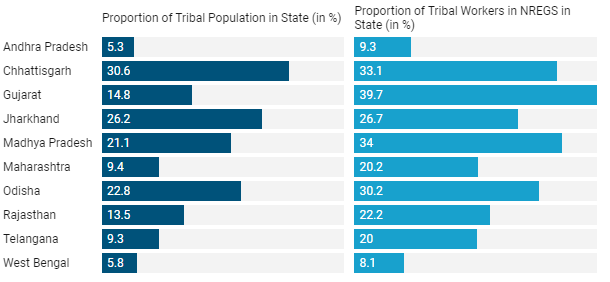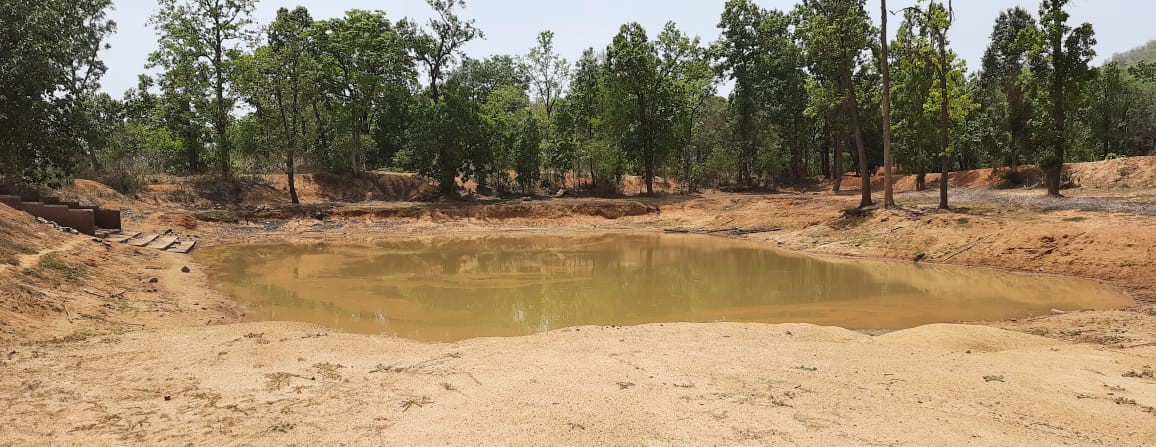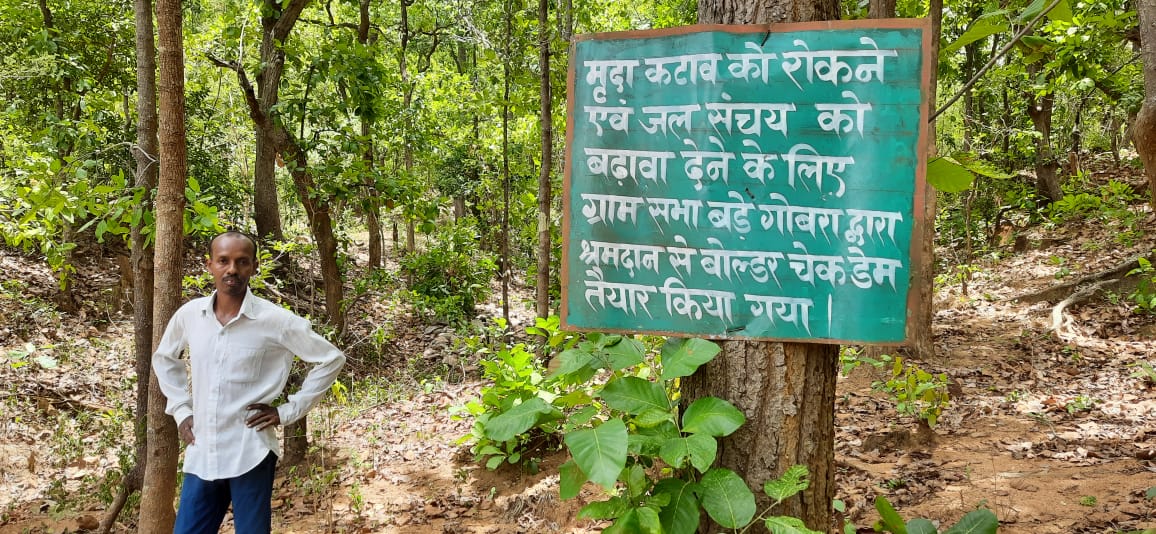
Chhattisgarh was carved out of Madhya Pradesh in 2000 in response to the demand for a separate state with the unique Chhattisgarhi identity. Among various facets that make up this identity, being a tribal state is also prominent. It is one of the ten states that constitute the Central Indian Tribal Belt (CITB). In fact, with more than 30% of its population identifying as tribal, it is the state with the highest tribal proportion among all the states of CITB.
The total Scheduled Tribe (ST) population in the state is 78 lakhs and their livelihood is predominantly agri-based — 88% of workers belonging to this tribal population are engaged in agriculture, 43% as cultivators and 45% as agricultural labours[i]. The proportion of irrigated land among STs is albeit only 10% with a high dependence on canal irrigation at 56%, followed by 26% on wells and tube wells, and 5% on tanks[ii].
This makes it incumbent to look at the state’s policies enabling agriculture and irrigation.
One of the key schemes currently being implemented in the state is the Narva Gurva Ghuruva Baadi or NGGB Scheme, which focusses on water sources conservation and restoration, livestock management, bio-manure, vermicomposting and vegetable gardening.

In addition to NGGB Scheme, the Saur Sujala Scheme, another state initiative, aims at providing solar-energy based irrigation to the farmers. More than 1 lakh solar-based pumps have been installed in the state till now under the Saur Sujala Scheme, benefitting the farmers, especially in rural and forest areas without electricity.
However, the focal scheme in this article is a national scheme that has performed remarkably in improving agriculture and irrigation in the state's rural areas, the Mahatma Gandhi National Rural Employment Guarantee Scheme or MGNREGS.
National Rural Employment Guarantee Act was implemented in 2005 and it paved way for right to work. By ensuring 100 days of employment to all eligible households, the Scheme ensured livelihood to the poorest of the country. Chhattisgarh, in 2013, ensured additional 50 days of employment using the state’s budget, so the Scheme’s beneficiaries in the state may get up to 150 days of employment. NREGA opened new avenues for rural poor and proved its worth especially during the pandemic when the cities were shut for the poor but work was available in the villages[iii].
In Chhattisgarh close to 11.3 lakh households have benefitted from the scheme. The state currently has more than 73 lakh active workers under NREGS. At 72%, this represents one of the highest proportions of active workers out of total workers.
The proportion of active workers in Madhya Pradesh is 64%, Uttar Pradesh is 50%, West Bengal is 49% and Bihar is 32% — some of the other states with high numbers of active workers. Another important aspect in this is the participation of tribal population. The proportion of ST workers in NREGS is consistently higher than their proportion in the population in all the states of CITB as given in the table below.

Several permissible works under the scheme, including the construction of goat and poultry sheds, roads, houses, farm ponds, dug wells, etc., were done in Chhattisgarh. Since its inception, the scheme has increased food availability, including higher nutrient, milk and vegetable intake, and, improvement in child education, and higher savings[iv].
NREGS’s primary objective is providing employment; however, the creation of assets, especially individual assets (as opposed to community assets) is one of the most beneficial results. For small and marginal farmers, the option of levelling and bunding their land and creation of farm ponds and wells along with other agriculture and water related works under NREGS, provides opportunity of a reliable income from agriculture.
In Narharpur Block of Kanker district, for example, 65% of the works were for land levelling or development or construction of farm ponds or wells in the individual category.
NREGS hence is proving to be effective in bringing previously uncultivable land under cultivation, previously unirrigated land under irrigation and in increasing the productivity of previously degraded land through land and water works. Among these, the creation of farm ponds was observed to be widespread in certain tribal areas of the state during a recent visit.
Among the places visited were Bhiraud and Marrampani, two villages in Narharpur block of Kanker district. Both villages are tribal majority villages, 65% of population in Bhiraud and 85% of population in Marrampani is ST. Along with agriculture, there is a strong dependence on forest for livelihood. Collection of NTFP like mahua flowers and kendu (also called tendu) leaves is widespread. The agriculture is predominantly rainfed. Of the total agriculture area belonging to STs in the Narharpur block, only about 9% is irrigated. In Bhiraud and Marrampani, this led to outmigration for livelihood, a lot of which is now changing due to work done under NREGS.

In the past ten years, 22 farm ponds in Bhiraud and 17 farm ponds in Marrampani have been constructed costing approximately Rs 81 lakhs (material and labour cost). This is the data from the NREGS dashboard. The latest data from the field revealed that in Bhiraud there are 90 farm ponds (many constructed in year 2021) and 50 more are planned. This is particularly celebratory from the point of groundwater conservation as during the same time the number of wells constructed in these two villages was 7 (six individual wells in Bhiraud and one community well in Marrampani).

The villagers stated that they have availed many benefits from these farm ponds and the farm ponds in a way have been life changing for them. Construction of these farm ponds through NREGS has provided them employment and water security.
Additionally, access to water for protective irrigation, especially for remunerative crops, has helped them to accrue agricultural profits. Now they can work on their own agricultural fields and do not have to migrate for work.
This is field experience from a few villages; in the state overall, 76985 farm ponds have been constructed under NREGS since the inception of the scheme.[v] The work on farm ponds under NREGS has improved the agri-based income, increased the crop yield of rice (one of the most remunerative crops in Chhattisgarh) and has led to increase in water holding capacity of soil and groundwater levels[vi].
A challenge that was frequently faced for construction of farm ponds was reluctance of farmers to sacrifice part of their land for the pond. For the farmers each fragment of their land is valuable. Over the years however, the value of farm ponds has also been recognized by the farmers looking at the positive impact generated by them. Lately, the demand for the farm ponds is coming from the farmers themselves.
Overall as well, tribal farmers have increasingly started to demand work such as land levelling, lift irrigation, farm ponds, check dams, trenches, etc. which will lead to reduced soil and water erosion and improved agriculture and irrigation.
Many times, when the demands cannot be fulfilled the tribals themselves come together to work. In one such case, villagers of Bade Gobra (Gariabandh District) came together to work on a boulder check dam. They constructed a series of 56 check dams in 2017 to prevent water and soil erosion.

NREGA, especially the construction of these farm ponds under the NREGS has brought in a new possibility for tribal farmers. Although the tribals recognize the significance of harvesting rainwater for irrigation or of irrigation for a healthy crop, inaccessibility to sufficient resources leaves them vulnerable and without any option other than migration.
Besides assuring 150 days of livelihood, NREGS in Chhattisgarh has most notably benefited the tribal farmers in accessing irrigation for their farmlands. A continued impetus on farm ponds would provide sustainable livelihoods to tribal farmers while assuring climate-smart surface-water-based non-exploitative irrigation.
[i] Population Census 2011
[ii] Agriculture Census 2015-16
[iii] Afridi, R., Mahajan, K., & Sangwan, N. (2021, 11 February). Did NREGA cushion job losses during Covid-19 crisis? The Wire.
[iv] Singh, P., & Kumar, D. (N.D.). Study of the drought affected districts and implementation of MGNREGA to provide livelihood security and arrest distress migration in Chhattisgarh state. Department of Rural Technology and Social Development, Guru Ghasidas Vishwavidyalaya Bilaspur
[v] Based on the data collected from NREGA MIS on 26th July 2022.
[vi] Singh, P., & Kumar, D. (N.D.). Technical quality and the economic assessments of the category b assets (dug wells and farm ponds) under MGNERGA and their impact on improving the income status of the beneficiary household in Chhattisgarh state. Department of Rural Technology and Social Development, Guru Ghasidas Vishwavidyalaya Bilaspur
/articles/mgnregs-becoming-quintessential-scheme-tribal-agriculture